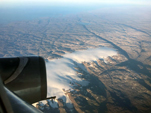 | 1: Getting Aboard: St. John's to Kugluktuk
We’re just beginning a month-long scientific journey to the Beaufort Sea on the Canadian icebreaker the CCGS Louis S. St.-Laurent. The Joint Ocean Ice Expedition is a collaboration of the Woods Hole Oceanographic Institution (WHOI) Beaufort Gyre Exploration Program with the Department of Fisheries and Ocean Canada, and I’m here on a National Science Foundation grant to capture in video, photos, and writing the exciting work of scientists who study the Beaufort. Men and women from many parts of the world represented by organizations in Canada, Japan, the United States and China come here in the dropping temperatures of Arctic autumn to study the physical properties of the Beaufort, its currents, chemistry, life forms, and ice formations. Some are new to the Arctic but many return year after year to collect more data. For those few modelers who work primarily in front of a computer screen all day, perhaps this is like nothing they’ve done before. |
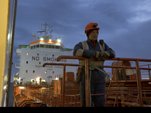 | 2: Refueling Before Departure
This afternoon 19 more scientists were ferried over from Kugluktuk after coming in on a flight from Yellowknife. I went aft to ask Chief Mate Trevor Hodgson if I could stand somewhere out of the way to make a video of today’s scientists landing on the boat. The shiny new red machine with the Canadian flag touched down like a feather on the red deck. |
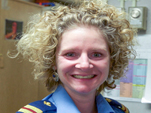 | 3: Under Way
We’re told to shut doors quietly, inner and outer, and to keep our voices down in the corridors since someone is always sleeping, someone always working. |
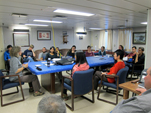 | 4: Let the Science Begin
At 12:45 PM after dinner (Canadian lunch), the continuous ringing of the General Alarm bells means to go to our Emergency Station. For most of us that’s the helicopter hanger aft. When we hear 7 shorter blasts followed by one long blast on the General Alarm or Ship’s Whistle we go to our Boat Station because it would mean we were abandoning ship. |
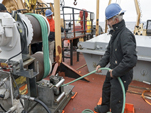 | 5: Some Louis Facts from the Information Handbook Onboard
Built in 1969, refitted and modernized in 1993 (it took five years), the Canadian Coast Guard Ship Louis S. St. Laurent is 393 feet long and 80 feet wide with a deadweight tonnage of 15,000 tons and a cruising range of 26,000 nautical miles (almost 30,000 regular miles), which is more than once around the circumference of the planet at the equator. |
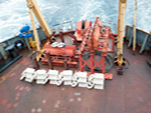 | 6: Drifters, Icebreakers, and Nets
“Drop drop drop...” Says Adam and also David. Which means one person on each side of the ship is dropping one of Jean Mensa’s drifters at the exact same time with evenly timed intervals in between. |
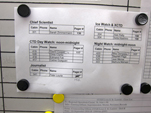 | 7: ICE
It really is looking very Arctic out there. Snowed at night and the railings and all the surfaces are coated with icy white. Some of the scientists are looking a little beleaguered. Having a shift of twelve hours, participating in the Rosette lowering and raising and complicated sampling that follows can take up to 90 minutes. Some in the night shift like Jean Mensa and Steve Page say they are getting the pattern of it, falling into a rhythm, but these first few days have been disorienting. |
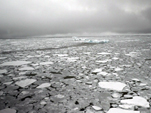 | 8: "Shuga" Ice
4 AM. I’m in the lounge typing this and Gillian who has been on the bridge says we’re getting into the “shuga” ice. She says it’s lovely up there, with a crescent moon appearing through the fog. The shuga ice will turn to pancake ice with the “motion of the ocean,” before it starts to bond to form bigger floes. |
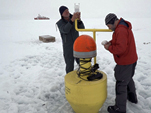 | 9: The Sounds of the Ice against the Louis
We started breaking some slightly more substantial ice last night moving north to find a good solid place for buoy deployment today. I fell asleep early while poker started up in the lounge and I woke to the jerk/shaking of the hull with intermittent sounds of scraping somewhere below. “We weren’t breaking big ice,” Logistics Officer Nathan Whiffen said, “maybe using only two of the Louis’ five motors.” |
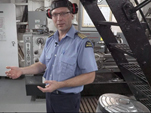 | 10: Busy Engine Room Below, Science Reports & Continued Water Sampling Above
O man, o man, today Chief Engineer, Danny Parmiter showed me the engine room. We put on ear protectors and went below the water line to a world filled with machines, engines, desalinators, computers and computer screens, a noisy child’s dream of pipes and metal, all the spaces amazingly clean and tidy for a 47-year-old ship. Danny showed me the Louis’ combination of new technology and old. Many of the original parts of the Louis still operate and are in great condition. I got it on video, and it’ll be fun to link the edited video to this page after I get home. I’ll store all the finished videos on my account at Vimeo and link them to these dispatches, so when you hit a link here, you’ll see the tour Danny gave me. Stay tuned on that!! |
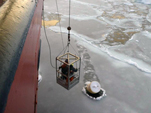 | 11: Recovering a Lonely Buoy
From the foredeck it seemed like the proverbial needle in the haystack. I mean an ITP buoy that has been sitting in the water and ice for two years just waiting for rescue. How would we ever find the yellow cork? |
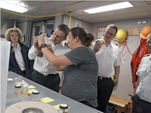 | 12: Weekends of Work and Play aboard the Louis
Weekends aboard the Louis have a different flavor from week days, but not by a whole heck of a lot. Work goes on round the clock, ship work, science work, the night people and the day people doing the rosette casts and collecting samples. Other scientists running water samples through their labs. |
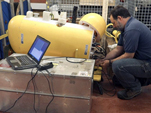 | 13: Deployments and Retrievals: ITPs & Moorings
Michiyo slept through Eggs Benedict on our first Sunday, so she didn’t let it happen again today. Something she remembers fondly from a former trip on the Louis. |
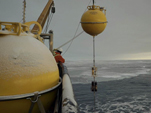 | 14: Icebeaker History & Today's Mooring Deployment
The first modern polar icebreaker the Yermak was built in England under contract from the Russian Navy at the end of the 19th century, 1897 to be exact, just two years after Norwegian explorer Fridtjof Nansen made it farthest north to 86 10’ to within 230 miles of the North Pole. The Yermak was so well constructed, it wasn’t fully decommissioned until 1963, 6 years before the Louis was built! Our icebreaker is 47 years old now, but the Yermak lived to 67! From everything I’ve seen onboard, the Louis is definitely in the same class of icebreaker longevity. |
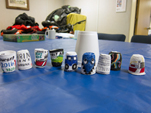 | 15: Entertainment Heading South Along the 150 Longitude Line
Now that we’re becoming familiar with each other and with the crew and we’re past the half way mark of the cruise, we’re heading confidently south before we head east again to make shallower CTD rosette casts along the coastal shelf. There’s a feeling onboard, perhaps more from the crew, that we’re on the downhill phase of the cruise. We all get off at Kugluktuk on the 18th and the crew will take the Louis another 9 days through the Northwest Passage back to Iqaluit on Baffin Island where a new crew will come aboard and our new friends will fly home. |
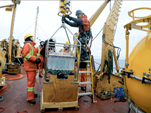 | 16: One-year-old Water Samples like Diamonds
Today we collected valuable data during WHOI’s second mooring recovery when Michiyo’s water sampling instrument came on deck. Very exciting to see an instrument being brought onboard that had been submerged for a whole year. |
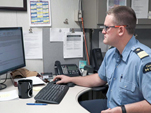 | 17: Logistics on the Louis
Nathan Whiffen, Logistics Officer on Canada’s largest icebreaker, has been working aboard the Louis off and on for the past five years. He oversees the financial administration, material management and hotel services on the ship. “Each year prior to going to the Arctic our ship partakes in what we call a ‘pre-Arctic’ operation where we prepare for our Arctic season, which actually begins at the end of the previous summer. Every year we take our orders; we see what parts we need, what equipment we’re going to carry, and what science programs we have for the year. We gel it all together into one big program to see what we’ll need to get us through the Arctic season, because as you know in the Arctic we don’t have much opportunity to resupply. If we run out of anything, we’re basically left without.” Nathan’s job is to make sure the Louis’ clients and crew have what they need to make it through the season, from May to November. |
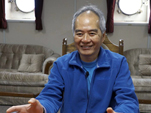 | 18: Collaboration: IT Aboard & Instruments Returned to the Sea
Edmand Fok from the Department of Fisheries and Oceans in British Columbia is the IT professional aboard with many roles to help scientists succeed in data collection. He has been on the majority of the JOIS trips to the Beaufort. His job is to make sure all of the computers are working and are linked to the main server. The many sensors from the different instruments that various scientists are using for their data collection are attached to different computers around the ship. Edmand’s job is to collect and feed all that data to the main server that then can be accessed by everyone. It makes it easier, Edmand says, when the information is amassed on a single server and each scientist can walk away with all the data on a USB flash drive when they leave the ship. |
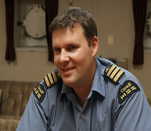 | 19: Interviewing Crew & More on Icebreakers
In the past two days I’ve had the opportunity to interview on video camera, Chief Officer Trevor Hodgson, Medical Officer Amelie Francoeur, and Chief Cook Blair Walsh. Much thanks to them for taking the time out of some very busy days. |
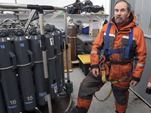 | 20: The Night Watch & Shallower Casts Over the Shelf
My sleeping hours have gotten all turned around during this cruise, so I often wake early and go to the mess hall for a snack and there the Night Watch can be found laughing and chowing down on last night’s leftovers, onion rings and home fries. In the middle of every night, seven days a week, four of the science crew roam a nearly empty ship. |
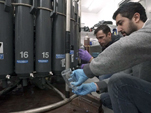 | 21: Collecting Beaufort Microbes
There have been some pretty late nights and a few of the samplers like Adam Monier are sometimes still awake working on their samples when I wake at 5.
This is Adam’s third time in the Arctic on a Canadian vessel. From the University of Exeter in England, Adam is French and used to work in Quebec City at Université Laval. With a specialty in ocean microbiology, he’s interested in marine microbes and how they are structured across the water column and how these microbial communities are changing in the environment.
|
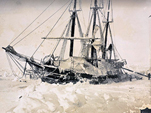 | 22: Arctic Oceanography from It's Beginnings
At the science meeting this morning Sarah reported that she’s very happy with the collecting and all the data we’ve been getting on this trip. The weather has cooperated amazingly well with calm seas. The sun is out now for a third day this week. We’re planning to finish the science by Saturday at midnight and then have a two-day process of packing up instruments and gear. She said we’ll be taking a few side trips in the next few days so we can fill in some gaps in data. XCTD only, after Saturday when the rosette casts will stop at midnight. Scientists are starting up their reports about their sampling. Reports and packing will take two days before we say goodbye to our new friends on the crew and take the helicopter off the ship to Kugluktuk for a flight to Yellowknife. |
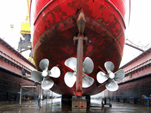 | 23: Icebreakers around the World
Chief Mate Trevor has mentioned before that the date for the Louis decommission has now been extended to at least 2021 and possibly 2023. Maybe living legends can’t live forever. I love the photo I found on the ship’s server of the Louis from a whole new perspective. The ship’s computers are filled with thousands of photos the crew and visiting scientists have taken over the years, many by one of the crew’s carpenter’s Gary Morgan, who can often be seen around the ship with his professional cameras and lenses. |
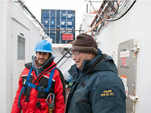 | 24: "The Last Rosette"
Outside it was snowing and the water was kicking up. Someone in the shack said,
A song should be written, The Last Rosette. The 24 Niskin bottles had just been rolled into the shack for the last time on this cruise after a shallow dive off the Mackenzie River delta. Only a few of the bottles had been filled at just over 100 meters, nothing like the long deep casts of up to 4000 meters on most of the trip. Mark wasn’t collecting for Oxygen, but Arthi, Adam and David filled their big bottles to sample for microbes.
|
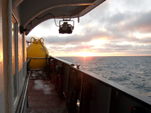 | 25: A Final Note of Gratitude
As if to say goodbye, today we headed into the morning sun. All day equipment and winter gear were being packed up, samples made shipping-ready. Once they get to Dartmouth, Nova Scotia, they’ll go overnight to scientists’ labs, not reaching their final destinations for almost another month. |
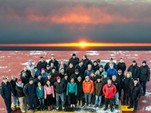 | 26: One Last Dispatch
This note comes from the Edmonton Airport, heading home to Victoria BC. It is quiet with no more boxes to pack or labs to empty. |




























